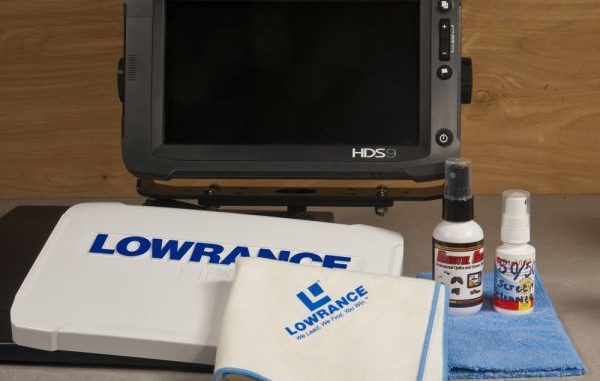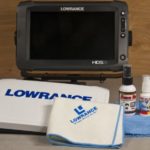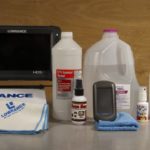
Dirty can cancel out hi-res screens
LCD screen brightness, contrast and resolution improve with every new generation of marine electronics. Higher pixel counts, new sonar technologies, more-vibrant colors and improved visibility under adverse light conditions let us see tiny sonar and chart details that would have been invisible a decade ago without zooming to enlarge the screen picture.
Unfortunately, this also means that each oily fingerprint, water spot and smudge on the display can hide more information than ever before, and keeping our screens clean has become considerably more important.
The best way to maintain a clean screen is to keep it from getting dirty in the first place. Most units now come with snap-on screen covers, and manufacturers suggest keeping them in place when units are not in use. If you trailer your boat with your electronics installed, this is especially important.
Personally, I prefer to trailer with my electronics in padded protective cases.
The dry grit that trailering on unpaved roads can put on your screens is especially abrasive. Attempting to remove this grit with a dry rag can permanently scratch or scuff a screen’s outer lens.
I remove dry grit by flooding the screen with water, and then wiping it gently with a dripping-wet cloth, turning the cloth often to present a clean part of it to the screen.
After the grit is removed, I proceed with normal cleaning. I’ll use a dedicated cleaner like Wilson Frazier’s Krystal Vision (itainttv.com) or a 50/50 mix of distilled water and isopropyl alcohol.
I either mist the screen with a squirt bottle or dampen a clean microfiber cloth with the liquid and gently wipe the screen. “Gently” is the key word here; pressing hard against some screens can damage pixels!
Finally, I dry the screen with a second clean microfiber cloth. I keep using the word “clean” because it’s important: A cloth bearing grit is like a sheet of sandpaper.
After using a microfiber cloth a few times, I run it through the washing machine with a load of clothes that don’t require fabric softener, and then either hang them up to dry or run them through the clothes dryer without using any of those fabric softener/anti-static dryer sheets.
Most traditional screens are covered by a protective polymer lens. It is not glass, and using glass cleaners containing ammonia or other harsh chemicals can permanently discolor it.
Scuffs and light scratches can be polished out using Meguiar’s Mirror Glaze No. 17 available at auto parts stores; just follow the directions on the squeeze bottle. I first saw this product used to polish out scratches in military aircraft canopies without distorting their optical properties.
Touchscreens are working their way into marine electronics and bringing new questions. How do you keep fingerprints off a screen that you have to touch, and how do you clean these screens without risking damage?
The owner’s manual for Lowrance’s new HDS Gen2 Touch suggests using the microfiber cloth that comes in the box. Where marks on the screen can’t be removed by the cloth alone, the manual recommends using a 50/50 mixture of warm water and isopropyl alcohol. It specifically warns against using solvents like acetone or mineral turpentine or ammonia- or vinegar-based cleaners because they may damage the anti-glare layer, the plastic bezel around the screen and the rubber keys.
Some 16 different types of touchscreens exist, and they are made with everything from flexible membranes to a super-tough material called Gorilla Glass.
One of the first touchscreens I acquired was built into a Garmin handheld GPS so, looking for more information about touchscreens, I got in touch with some of Garmin’s technical experts.
Garmin uses resistive, infrared, surface-capacitive and projected-capacitive screens for its various products. You can find an in-depth look at touchscreen types at en.wikipedia.org/wiki/Touchscreen.
Each screen type offers its own advantages, and Garmin selects screens based on a product’s purpose and specific requirements for its use.
Some screens are pressure sensitive and work even when you wear gloves. Others don’t work when gloves are worn unless they have special conductive fabric pads on the fingertips that do the touching.
Garmin said these gloves will help when using any type of projected-capacitive screens and shouldn’t cause any damage to the outer lens, as long as the gloves are clean.
Since the company serves various markets, it has designed some of its touchscreens to work with gloved hands even if the gloves do not have conductive pads. Their screens for fitness products and other outdoor devices work well with gloves and aren’t bothered by sweat.
Garmin’s marine screens have been designed to function well even when wet.
Garmin says keeping touchscreens clean is the best way to prevent damage, and advocates keeping them covered and protected when not in use. The company suggests not using abrasive cleaning materials and not handling the screens if there is any abrasive substance on your gloves or hands.
Cleaning touchscreens with a lightly damp, lint-free cloth is recommended.
I asked if a scratched screen could be polished out or if the screen would have to be replaced, and the answer is that it depends on the screen’s type. Projected-capacitive and infrared touchscreen displays are similar to any other glass surface, and polishing only works well on plastic lenses. The top surface of a resistive touchscreen is a film, so it cannot be repaired.
A call to a unit manufacturer’s customer service number will reveal which kind of screen a unit has and whether it can be repaired or must be replaced.
The bottom line: A few minutes of preventative care and cleaning are worth a wallet full of cure where LCD screens (touch or otherwise) are concerned.
I don’t know about you but I’d rather spend minutes than money.




